
Macy's (M)
We wouldn’t recommend Macy's. Its low returns on capital and plummeting sales suggest it struggles to generate demand and profits, a red flag.― StockStory Analyst Team
1. News
2. Summary
Why We Think Macy's Will Underperform
With a storied history that began with its 1858 founding, Macy’s (NYSE:M) is a department store chain that sells clothing, cosmetics, accessories, and home goods.
- Store closures and disappointing same-store sales suggest demand is sluggish and it’s rightsizing its operations
- Sales are expected to decline once again over the next 12 months as it continues working through a challenging demand environment
- Subpar operating margin constrains its ability to invest in process improvements or effectively respond to new competitive threats


Macy's is in the penalty box. We believe there are better opportunities elsewhere.
Why There Are Better Opportunities Than Macy's
Why There Are Better Opportunities Than Macy's
Macy's is trading at $22.30 per share, or 10.5x forward P/E. This multiple is high given its weaker fundamentals.
Paying a premium for high-quality companies with strong long-term earnings potential is preferable to owning challenged businesses with questionable prospects. That helps the prudent investor sleep well at night.
3. Macy's (M) Research Report: Q3 CY2025 Update
Department store chain Macy’s (NYSE:M) reported Q3 CY2025 results exceeding the market’s revenue expectations, but sales were flat year on year at $4.91 billion. The company’s full-year revenue guidance of $21.55 billion at the midpoint came in 1.1% above analysts’ estimates. Its non-GAAP profit of $0.09 per share was significantly above analysts’ consensus estimates.
Macy's (M) Q3 CY2025 Highlights:
- Revenue: $4.91 billion vs analyst estimates of $4.73 billion (flat year on year, 3.9% beat)
- Adjusted EPS: $0.09 vs analyst estimates of -$0.13 (significant beat)
- Adjusted EBITDA: $285 million vs analyst estimates of $210.5 million (5.8% margin, 35.4% beat)
- The company lifted its revenue guidance for the full year to $21.55 billion at the midpoint from $21.3 billion, a 1.2% increase
- Management raised its full-year Adjusted EPS guidance to $2.10 at the midpoint, a 12% increase
- Operating Margin: 0.9%, in line with the same quarter last year
- Free Cash Flow was -$190 million compared to -$384 million in the same quarter last year
- Same-Store Sales rose 3.2% year on year (-2.4% in the same quarter last year)
- Market Capitalization: $6.10 billion
Company Overview
With a storied history that began with its 1858 founding, Macy’s (NYSE:M) is a department store chain that sells clothing, cosmetics, accessories, and home goods.
As the name suggests, a department store offers a wide variety of merchandise organized into different departments or sections. Before the introduction of department stores in the 19th century, consumers would have to visit three different stores to buy a hat, a bottle of perfume, and pillows for their bedroom. While not the first department store, Macy’s was a pioneer.
Today, the core customer is a woman between the ages of 25 and 54 who is looking for name-brand products in a variety of categories. This customer can find prominent brands such as Calvin Klein, Levi’s, MAC, Cuisinart, and Sony in a Macy’s store or on its e-commerce site. Stores tend to be large, between 100,000 and 200,000 square feet, and serving as anchor tenants in many suburban malls. Common departments in a store include women’s/men’s/children’s apparel, beauty/cosmetics, and home goods. Additionally, Macy's has an active e-commerce presence, launched in 1997 as one of the first major retailers to offer online purchases.
Since the introduction of e-commerce, Macy’s and peers have faced increased competition. Evolving specialty retailers and developments such as fast fashion have also pressured the department store model.
4. Department Store
Department stores emerged in the 19th century to provide customers with a wide variety of merchandise under one roof, offering a convenient and luxurious shopping experience. They played an important role in the history of American retail and urbanization, and prior to department stores, retailers tended to sell narrow specialty and niche items. But what was once new is now old, and department stores are somewhat considered a relic of the past. They are being attacked from multiple angles–stagnant foot traffic at malls where they’ve served as anchors; more nimble off-price and fast-fashion retailers; and e-commerce-first competitors not burdened by large physical footprints.
Department or general merchandise retail competitors include Nordstrom (NYSE:JWN), Kohl’s (NYSE:KSS), and Dillard’s (NYSE:DDS).
5. Revenue Growth
A company’s long-term performance is an indicator of its overall quality. Any business can put up a good quarter or two, but many enduring ones grow for years.
With $22.71 billion in revenue over the past 12 months, Macy's is one of the larger companies in the consumer retail industry and benefits from a well-known brand that influences purchasing decisions. However, its scale is a double-edged sword because it’s harder to find incremental growth when you’ve penetrated most of the market. For Macy's to boost its sales, it likely needs to adjust its prices or lean into foreign markets.
As you can see below, Macy's struggled to generate demand over the last three years (we compare to 2019 to normalize for COVID-19 impacts). Its sales dropped by 4.2% annually as it closed stores and observed lower sales at existing, established locations.
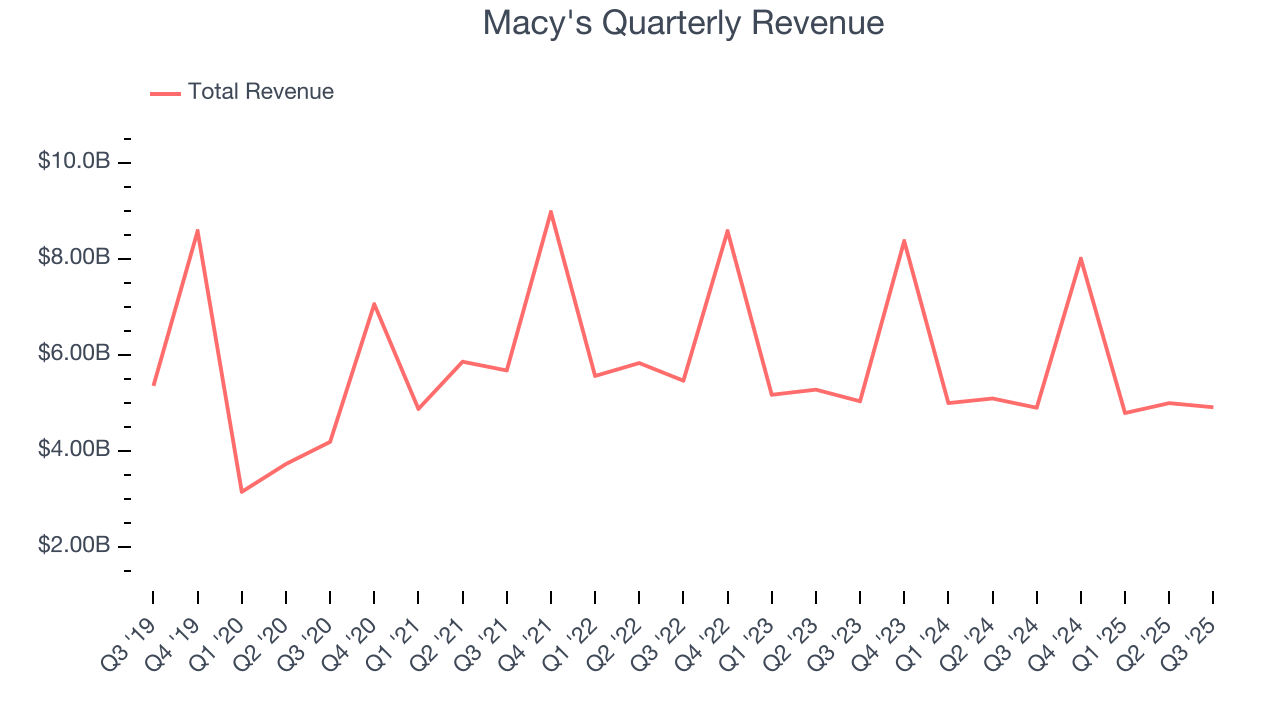
This quarter, Macy’s $4.91 billion of revenue was flat year on year but beat Wall Street’s estimates by 3.9%.
Looking ahead, sell-side analysts expect revenue to decline by 4.1% over the next 12 months, similar to its three-year rate. This projection is underwhelming and implies its newer products will not lead to better top-line performance yet.
6. Store Performance
Number of Stores
The number of stores a retailer operates is a critical driver of how quickly company-level sales can grow.
Macy's has generally closed its stores over the last two years, averaging 5.5% annual declines.
When a retailer shutters stores, it usually means that brick-and-mortar demand is less than supply, and it is responding by closing underperforming locations to improve profitability.
Note that Macy's reports its store count intermittently, so some data points are missing in the chart below.
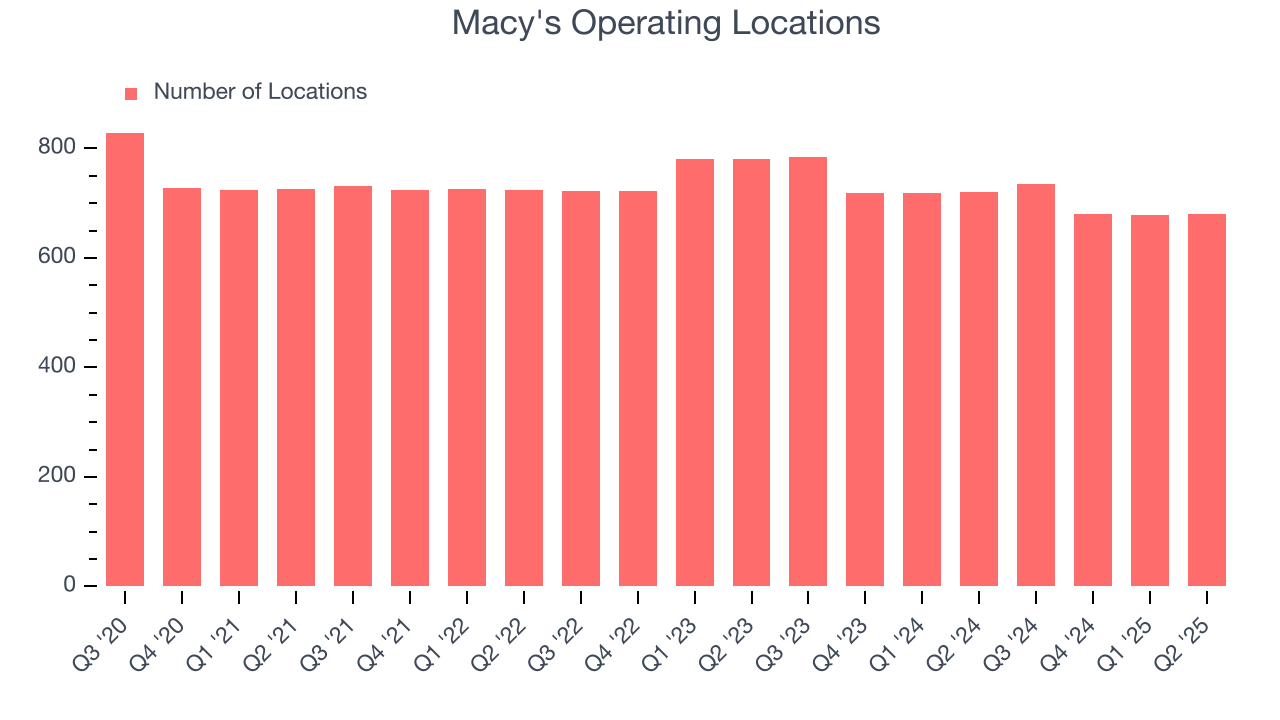
Same-Store Sales
A company's store base only paints one part of the picture. When demand is high, it makes sense to open more. But when demand is low, it’s prudent to close some locations and use the money in other ways. Same-store sales is an industry measure of whether revenue is growing at those existing stores and is driven by customer visits (often called traffic) and the average spending per customer (ticket).
Macy’s demand has been shrinking over the last two years as its same-store sales have averaged 1.5% annual declines. This performance isn’t ideal, and Macy's is attempting to boost same-store sales by closing stores (fewer locations sometimes lead to higher same-store sales).
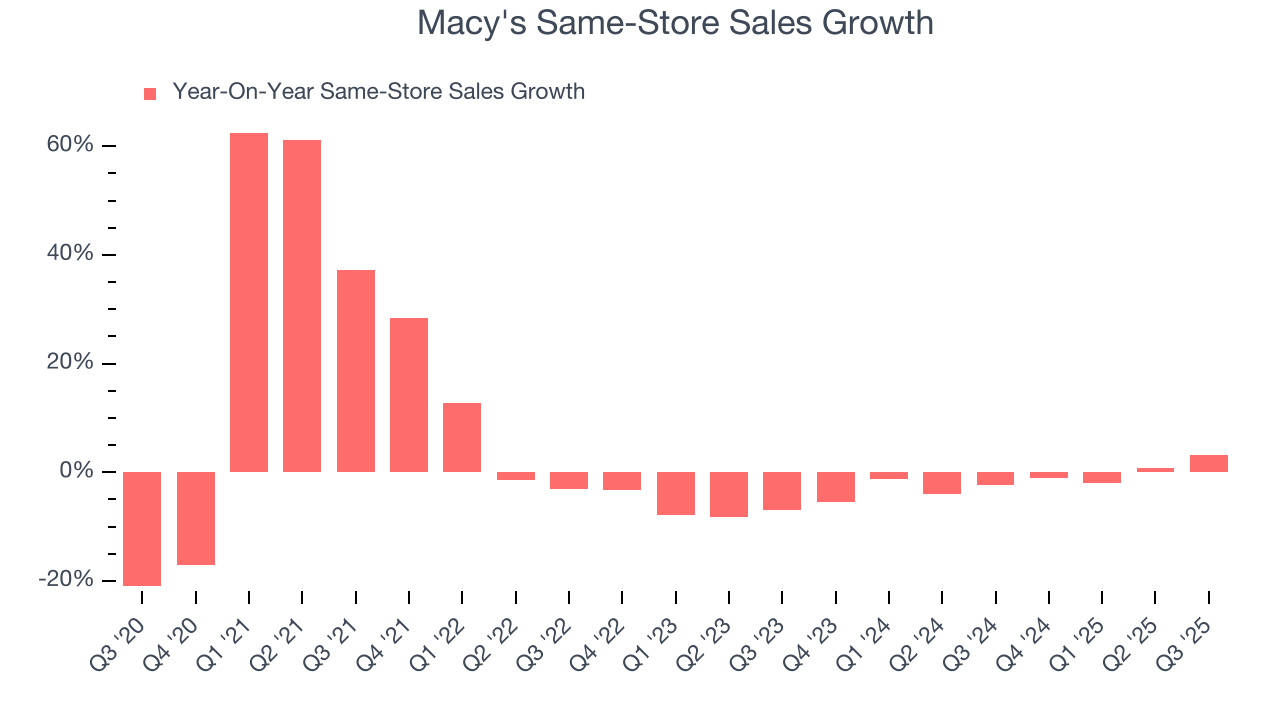
In the latest quarter, Macy’s same-store sales rose 3.2% year on year. This growth was a well-appreciated turnaround from its historical levels, showing the business is regaining momentum.
7. Gross Margin & Pricing Power
Macy’s unit economics are higher than the typical retailer, giving it the flexibility to invest in areas such as marketing and talent to reach more consumers. As you can see below, it averaged a decent 40.5% gross margin over the last two years. Said differently, Macy's paid its suppliers $59.55 for every $100 in revenue. 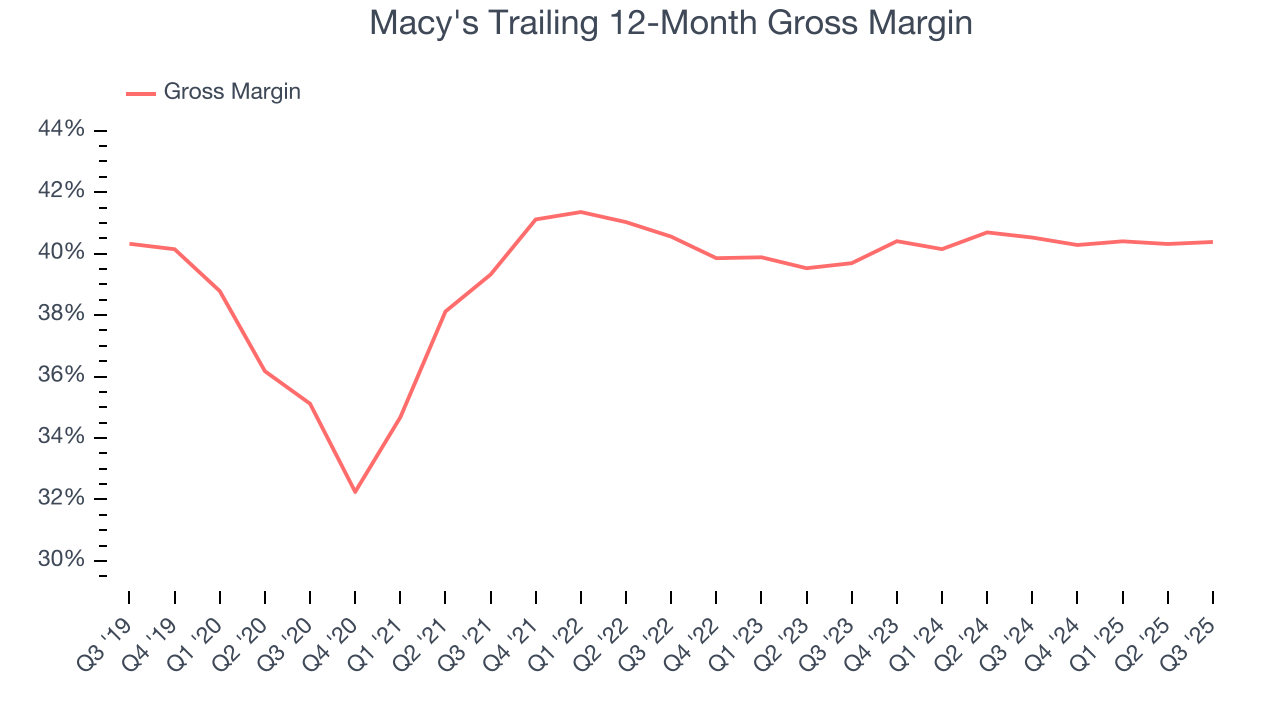
Macy's produced a 41.9% gross profit margin in Q3, in line with the same quarter last year. Zooming out, the company’s full-year margin has remained steady over the past 12 months, suggesting it strives to keep prices low for customers and has stable input costs (such as labor and freight expenses to transport goods).
8. Operating Margin
Operating margin is a key measure of profitability. Think of it as net income - the bottom line - excluding the impact of taxes and interest on debt, which are less connected to business fundamentals.
Macy's was profitable over the last two years but held back by its large cost base. Its average operating margin of 2.3% was weak for a consumer retail business.
On the plus side, Macy’s operating margin rose by 2.3 percentage points over the last year.
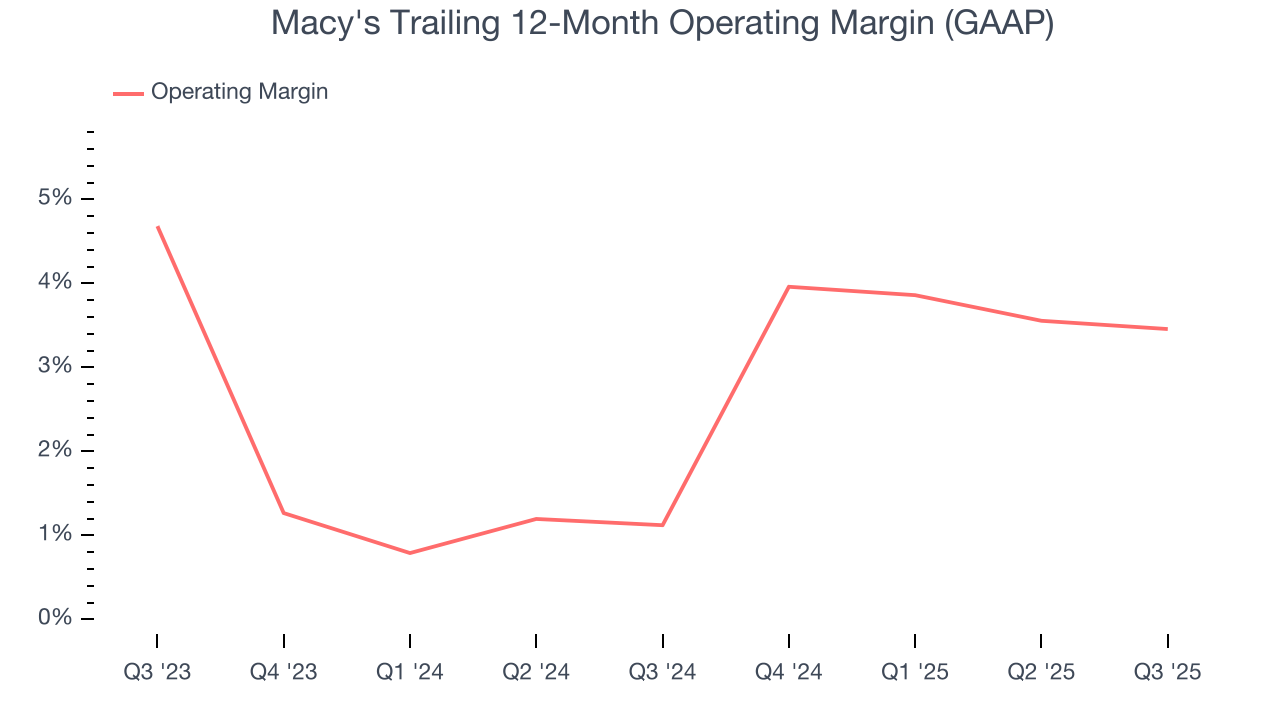
In Q3, Macy’s breakeven margin was in line with the same quarter last year. This indicates the company’s cost structure has recently been stable.
9. Cash Is King
If you’ve followed StockStory for a while, you know we emphasize free cash flow. Why, you ask? We believe that in the end, cash is king, and you can’t use accounting profits to pay the bills.
Macy's has shown mediocre cash profitability over the last two years, giving the company limited opportunities to return capital to shareholders. Its free cash flow margin averaged 2.2%, subpar for a consumer retail business.
Taking a step back, an encouraging sign is that Macy’s margin expanded by 2.6 percentage points over the last year. We have no doubt shareholders would like to continue seeing its cash conversion rise as it gives the company more optionality.
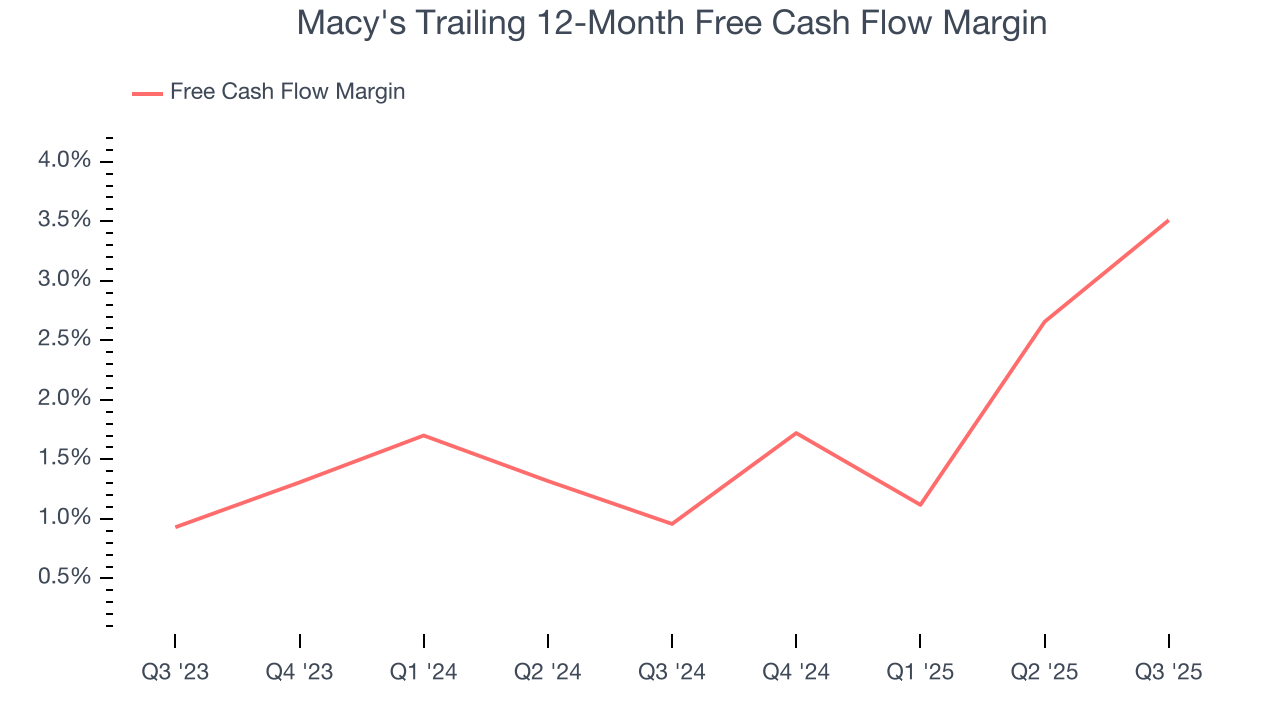
Macy's burned through $190 million of cash in Q3, equivalent to a negative 3.9% margin. The company’s cash burn slowed from $384 million of lost cash in the same quarter last year. These numbers deviate from its longer-term margin, indicating it is a seasonal business that must build up inventory during certain quarters.
10. Return on Invested Capital (ROIC)
EPS and free cash flow tell us whether a company was profitable while growing its revenue. But was it capital-efficient? Enter ROIC, a metric showing how much operating profit a company generates relative to the money it has raised (debt and equity).
Macy's historically did a mediocre job investing in profitable growth initiatives. Its five-year average ROIC was 9.6%, somewhat low compared to the best consumer retail companies that consistently pump out 25%+.
11. Balance Sheet Assessment
Macy's reported $447 million of cash and $5.24 billion of debt on its balance sheet in the most recent quarter. As investors in high-quality companies, we primarily focus on two things: 1) that a company’s debt level isn’t too high and 2) that its interest payments are not excessively burdening the business.
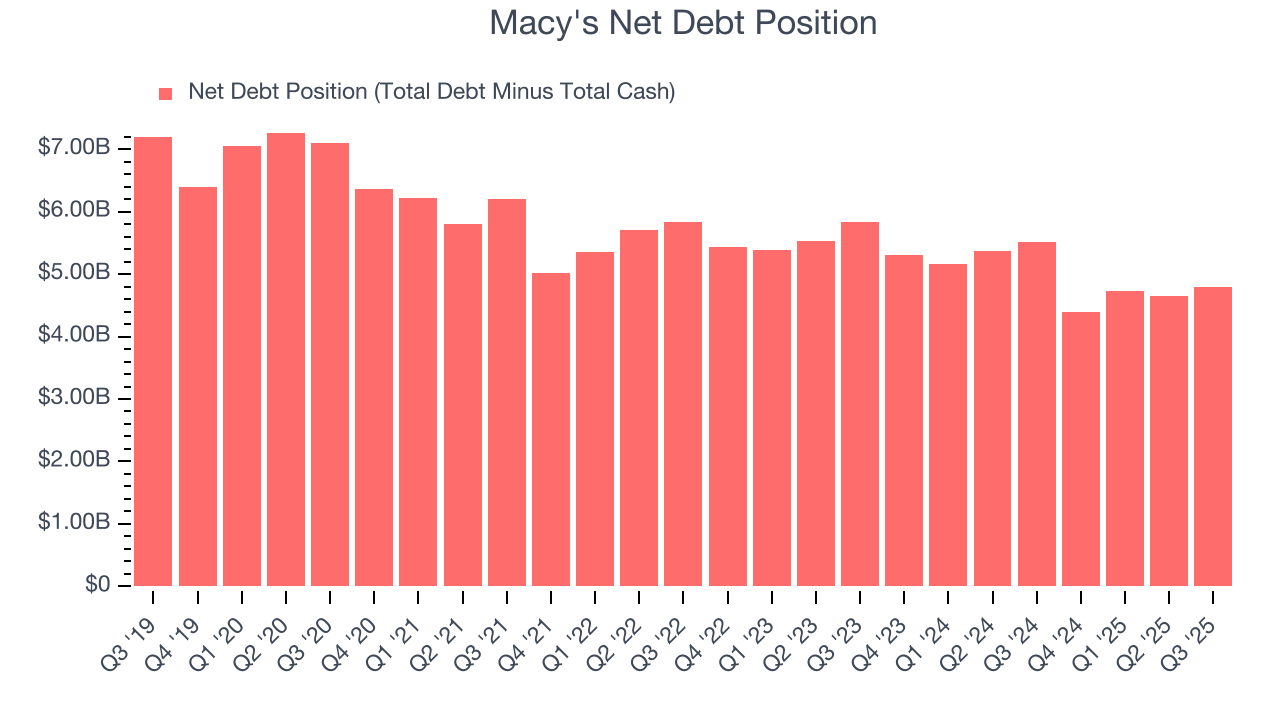
With $1.89 billion of EBITDA over the last 12 months, we view Macy’s 2.5× net-debt-to-EBITDA ratio as safe. We also see its $98 million of annual interest expenses as appropriate. The company’s profits give it plenty of breathing room, allowing it to continue investing in growth initiatives.
12. Key Takeaways from Macy’s Q3 Results
It was good to see Macy's beat analysts’ revenue and EPS expectations this quarter. We were also excited its full-year guidance was raised. Zooming out, we think this was a solid print with some key areas of upside. The stock remained flat at $22.69 immediately after reporting.
13. Is Now The Time To Buy Macy's?
Updated: December 24, 2025 at 9:36 PM EST
We think that the latest earnings result is only one piece of the bigger puzzle. If you’re deciding whether to own Macy's, you should also grasp the company’s longer-term business quality and valuation.
Macy's doesn’t pass our quality test. To begin with, its revenue has declined over the last three years, and analysts don’t see anything changing over the next 12 months. And while its popular brand gives it meaningful influence over consumers’ purchasing decisions, the downside is its declining physical locations suggests its demand is falling. On top of that, its declining EPS over the last three years makes it a less attractive asset to the public markets.
Macy’s P/E ratio based on the next 12 months is 10.5x. This valuation tells us a lot of optimism is priced in - we think there are better opportunities elsewhere.
Wall Street analysts have a consensus one-year price target of $21.80 on the company (compared to the current share price of $22.30), implying they don’t see much short-term potential in Macy's.







